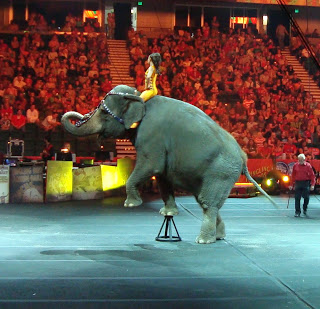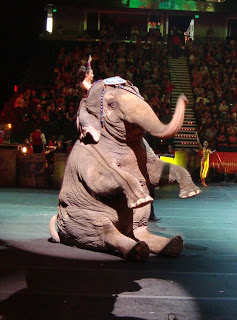I only faintly remember going to a circus once as a child. I remember a trapeze artist who was a beautiful lady who hung from her hair and I wanted to be just like her. Guess that didn’t happen.
When I heard that the Ringling Bros. and Barnum & Bailey circus was in Moline this weekend, I thought it would be a fun thing for Kevin & I to go to. Innocence truly is bliss. The first half of the show was good, not great, but at least a little entertaining. I do remember thinking that the elephants looked really weary, but nothing else struck me as crazy.
Then during intermission, Kevin & I read an article online about the mistreatment of animals at the circus and my insides just about hurled. Thank God the second half of the show was much shorter because I was just so sad. Here’s part of the article that we read…
Ringling Bros. and Barnum & Bailey Circus paints a picture of happy animals performing tricks because they like doing them. Consider the following, then decide whether that’s true. Here are some of Ringling’s frequent claims juxtaposed with the facts about the circus’s treatment of animals:
Ringling:
Our training methods are based on continual interaction with our animals, touch and words of praise, and food rewards.
Reality:
Video footage taken between 2001 and 2006 of Ringling trainers and handlers shows that elephants were aggressively hooked, lame elephants were forced to perform and travel, and a trainer inflicted a bloody bullhook wound behind an elephant’s ear flap. Former Ringling employees that left the circus in 2006 and 2007 describe violent beatings as well as the routine abuse of elephants, horses, camels, and zebras.
Ringling:
The ankus (bullhook) is used as an extension of the handler’s arm to guide the elephants.
Reality:
The bullhook, by design, is intended to cause pain and puncture the skin. Despite its appearance, an elephant’s skin is as sensitive as humans’ skin. The sharp metal hook on the end of the bullhook bruises, punctures, and tears elephants’ skin easily and often. Former Ringling animal crew employees report that the circus keeps a bag of topsoil handy to cover up bloody bullhook wounds on elephants.
Ringling:
Ringling is a leading expert in the care of Asian elephants. Our staff is dedicated to meeting our animals’ physical and behavioral needs.
Reality:
Ringling’s U.S. Department of Agriculture (USDA) inspection reports are riddled with serious citations of problems that directly impact animal welfare. In 2006 alone, the circus was cited three times for failure to provide adequate veterinary care to a disabled elephant, to an elephant with a large swelling on her rear leg, and to a camel with bloody wounds. Also in 2006, Ringling was cited for causing trauma, behavioral stress, physical harm, and discomfort to two young elephants who sustained cuts and abrasions when they ran amok in an arena in Puerto Rico; improper handling of dangerous animals; and an enclosure in disrepair.
Ringling:
Our staff are experts in their fields.
Reality:
Staff caring for animals in circuses may have little experience or formal training, increasing the potential for improper handling. Ringling regularly hires inexperienced people, some directly out of homeless shelters, and allows them to work with animals.
Ringling:
Ringling is attempting to save endangered Asian elephants from extinction.
Reality:
Ringling breeds elephants solely to perform in its circus. None of Ringling’s elephants can ever be released to the wild. Of the approximately 62 elephants owned by Ringling in 1990, 57 were captured in the wild. And at least 24 elephants have died since 1992. Ringling has not been successful in breeding more elephants than it has captured and imported for use in its traveling show, and its elephants are dying at a faster rate than they are breeding. Ringling routinely pulls unweaned elephants from their mothers to train them and put them on the road.
Ringling:
The animal routines in our circus showcase our animals’ natural behaviors.
Reality:
In nature, elephants don’t stand on their heads, walk trunk-to-tail, skip, crawl, or twirl, and adult female elephants do not mount one another. Tigers don’t hop on their hind legs and roll over in unison. In order to force wild animals to perform difficult and confusing circus tricks, trainers use whips, sticks, and bullhooks.
Ringling:
The public display of exotic and endangered animals contributes to a heightened awareness of humans’ responsibility to safeguard and protect these animals.
Reality:
According to David Hancocks, former director of the Woodland Park Zoo in Seattle, “When [circuses] portray animals as freaks and curiosities, devoid of context or dignity, circuses are perpetuating outdated attitudes. Wild animals in the circus are reduced to mere caricatures of their kind, exhibited just for financial gain. In this way, they corrupt our children, promoting the notion that exploitation and degradation is acceptable, even brave or funny.”
Ringling:
We operate a 200-acre state-of-the-art facility dedicated to breeding, research, and retirement of Asian elephants.
Reality:
The elephants at Ringling’s breeding compound in Florida only have access to a fraction of the property. When they are not chained, the elephants are confined to barns and small, barren outdoor paddocks. Ringling’s Williston, Fla., facility—also referred to as its retirement center—has several elephants who are infected with or exposed to a human strain of tuberculosis, Mycobacterium tuberculosis(TB). In September 2006, two male elephants at its breeding center also tested positive for TB and three female elephants were pulled off the road because they had been exposed to diseased elephants.
Ringling:
Ringling Bros. elephants are healthy, thriving, vigorous, and content.
Reality:
The USDA has noted on Ringling inspection reports that some of the circus’s elephants suffer from lameness, foot abscesses, and arthritis. At least eight of the 24 elephant deaths at Ringling since 1992 were attributable to either osteoarthritis or a chronic foot problem—a common problem in captive elephants caused by lack of space and forced inactivity. In a book titled The Elephant’s Foot, former Ringling veterinarian Gary West contributed a chapter about foot care. West wrote, “Foot-related conditions and arthritis are the leading cause of euthanasia in captive elephants in the United States.”
(credit where credit is due…)
So overall, I decided that I don’t like the circus as much as I thought I might. Kevin & I are avid Planet Earth/Discovery Channel watchers and I will be the first to say that none of those animals last night looked even half as good as they do in the wild when being filmed by camoflauged film crews. I thought that they would look more spectacular in real life, but I have decided that my definition of “real life” is not their definition of “real life.” I left the circus feeling a deep sense of sadness for all of them. What would it be like to long to perform in front of people because that’s the only place where you are safe from being beaten?
Shows like Cirque du Soleil are way more my speed. I love the human acrobatics and unreal stunts that Cirque shows pull off. They are classy, animal-free, and amazing. I think they might be the only kind of circus-y shows I’ll be paying for from now on. (On a side note, Kevin & I are going to the brand new Cirque show opening in Chicago! I am so excited out of my mind!! It’s on our bucket list to see every Cirque show before we die.)



add a comment
+ COMMENTS